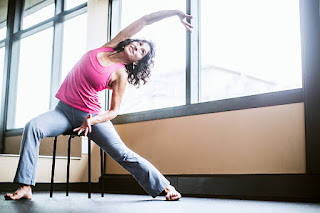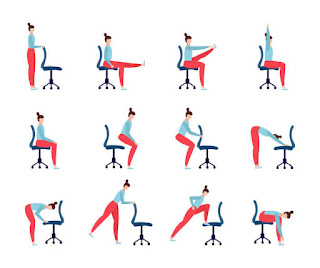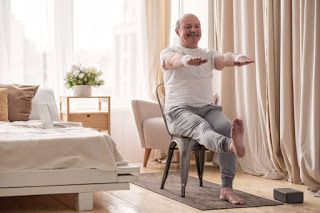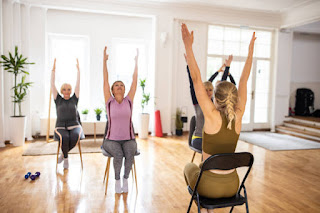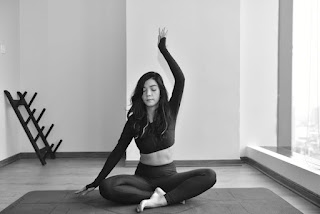Yoga Therapy for Mobility and Rehabilitation: How to Use Chair Yoga for Recovery
How to Use Chair Yoga for Recovery
Recovery from an injury, surgery, or a condition like multiple sclerosis or a spinal cord injury can be a long, challenging journey. However, incorporating chair yoga into a rehabilitation routine offers a powerful way to support physical recovery, build strength, enhance flexibility, and promote emotional well-being. Chair yoga, an adaptive form of yoga, provides a low-impact, gentle method of movement that makes it accessible for those who may have mobility challenges or require assistance.
This article will explore how chair yoga can be used as an effective tool for recovery, focusing on its benefits for physical mobility, mental well-being, and its integration into various rehabilitation programs. By emphasizing safe yoga practice, the role of rehabilitative therapists, and the potential benefits for individuals with chronic conditions, this approach opens up new possibilities for healing and improving quality of life.
What is Chair Yoga?
Chair yoga is a form of adaptive yoga that allows individuals to perform a variety of poses while sitting in a chair or using a chair for support. Traditional yoga poses are modified to make them accessible for people who may have difficulty standing, balancing, or getting down on the floor. This form of yoga can be practiced by anyone, regardless of age, fitness level, or physical limitations.
Chair yoga can be particularly beneficial for seniors, people recovering from injuries, those living with chronic pain, and individuals with conditions such as multiple sclerosis, cerebral palsy, spinal cord injuries, or traumatic brain injuries. By adapting the practice to meet their needs, chair yoga helps these individuals regain mobility, improve flexibility, reduce stress, and enhance their mental and emotional health.
The Role of Chair Yoga in Rehabilitation
For those recovering from an injury or surgery, or dealing with chronic conditions, physical therapy is often a key component of their recovery plan. Yoga therapy, especially chair yoga, is an excellent complement to physical therapy, offering safe, gentle movements that can help rebuild strength, improve range of motion, and enhance overall mobility. Here’s how chair yoga supports rehabilitation:
- Improving Physical Mobility: Chair yoga helps individuals gently stretch their muscles and move their joints, which can gradually increase their flexibility and mobility. For people recovering from surgery or managing conditions like arthritis or spinal cord injuries, chair yoga allows them to move in ways that are safe and supported, reducing the risk of further injury.
- Building Strength: Strengthening muscles is crucial in recovery, especially for those who have been immobilized due to injury or surgery. Chair yoga provides a way to engage the muscles in the arms, legs, back, and core without overexertion. Poses such as Seated Warrior I & II and Seated Eagle Pose help build strength while maintaining stability.
- Enhancing Balance and Coordination: Many people in rehabilitation struggle with balance and coordination, especially those recovering from a stroke or traumatic brain injury. Chair yoga offers poses that gently challenge balance while providing the stability of a chair for support. Regular practice can improve balance, reduce the risk of falls, and help individuals regain coordination.
- Reducing Pain and Inflammation: One of the significant benefits of chair yoga is its ability to relieve chronic pain and inflammation. For those recovering from injury, surgery, or managing chronic conditions like multiple sclerosis or arthritis, gentle movement helps to improve circulation, reduce stiffness, and alleviate pain. Poses such as Seated Forward Bend or Reclined Savasana are excellent for gently stretching and relaxing the body, helping to release built-up tension in the muscles and joints.
- Aiding Posture Improvement: After an injury, especially one affecting the back or spine, maintaining proper posture is crucial for recovery. Chair yoga emphasizes alignment and helps individuals become more aware of their posture during movement. Seated Mountain Pose is a foundational posture that teaches proper alignment and engages the core muscles, which helps in maintaining spinal health during recovery.
Mental and Emotional Benefits of Chair Yoga in Rehabilitation
Beyond its physical benefits, chair yoga also plays a vital role in supporting mental and emotional health, which is often overlooked during rehabilitation. Here’s how chair yoga aids in holistic recovery:
- Reducing Stress and Anxiety: Injury, illness, or surgery often leads to feelings of stress and anxiety. Chair yoga incorporates breathing exercises and mindfulness practices that help reduce stress, calm the nervous system, and promote relaxation. Breathing exercises, such as Ujjayi or alternate nostril breathing, are simple yet effective techniques for managing stress. These mindful movements can help shift attention away from pain or worry, allowing individuals to focus on their healing process.
- Boosting Mental Clarity and Focus: Many people recovering from traumatic brain injuries or strokes may struggle with cognitive function. Chair yoga integrates mindful movement with focused breathing, which can enhance mental clarity and concentration. The mind-body connection in yoga helps improve cognitive function, offering a mental workout that complements the physical exercises.
- Encouraging Emotional Resilience: Coping with injury or chronic illness can take an emotional toll. Chair yoga creates space for individuals to connect with their bodies, release emotional tension, and cultivate a sense of peace. Regular practice can lead to improved emotional well-being, reducing feelings of depression and isolation that are common during recovery.
- Fostering a Sense of Accomplishment: In rehabilitation, progress can be slow, and individuals may become frustrated with their limitations. Chair yoga offers a way to experience small, measurable improvements, fostering a sense of accomplishment and motivation. Whether it’s gaining a little more flexibility or holding a pose for longer, these achievements can be empowering.
Integrating Chair Yoga with Rehabilitative Therapy
One of the unique aspects of chair yoga is its adaptability, making it an ideal addition to rehabilitative therapy. Here’s how it can be effectively integrated into a rehabilitation program:
- Collaboration with Physical Therapists: Physical therapists often incorporate yoga into their treatment plans because of its rehabilitative potential. By collaborating with a physical therapist, individuals can tailor chair yoga sessions to target specific areas of the body that need attention. For example, those recovering from knee surgery might focus on poses that strengthen the quadriceps and improve knee flexibility without placing strain on the joint.
- Guidance from Certified Yoga Teachers: It’s essential that individuals practicing chair yoga in a rehabilitation setting work with certified yoga teachers who have experience in adaptive yoga and yoga therapy. These teachers can provide modifications and ensure that the practice is safe and supportive, especially for those dealing with mobility challenges or recovering from injuries.
- Safe Yoga Practice for Different Conditions: Chair yoga can be adapted to suit a wide range of conditions, making it accessible for individuals with varying levels of mobility. Whether someone is recovering from a stroke, managing multiple sclerosis, or dealing with chronic pain, the practice can be customized to meet their unique needs. For those with spinal cord injuries, poses that involve gentle spinal twists or core engagement can help strengthen the back and improve posture without overexertion.
- Incorporating Yoga Therapy into Long-Term Recovery Plans: Chair yoga can be an essential part of a long-term recovery plan, helping individuals transition from rehabilitative therapy back to daily life. As they regain strength and mobility, individuals can gradually increase the intensity of their yoga practice, moving from seated poses to standing or lying down yoga poses as they feel comfortable.
Chair Yoga Poses for Recovery
Here are a few chair yoga poses commonly used in rehabilitation settings:
- Seated Forward Bend (Uttanasana): This pose helps stretch the back, hamstrings, and shoulders while promoting relaxation. It is particularly beneficial for individuals with tightness in their lower back or hamstrings due to prolonged sitting or immobility.
- Seated Spinal Twist: A gentle twist that helps improve spinal mobility and digestion. This pose is ideal for individuals recovering from back surgery or those dealing with stiffness in their spine.
- Seated Warrior I & II: These poses are excellent for building strength in the legs, core, and arms. They help improve stability and coordination, which is crucial for individuals recovering from injuries affecting their balance or mobility.
- Seated Pigeon Pose: This hip-opening pose is ideal for stretching tight hip muscles, which are often a source of discomfort for individuals who spend long periods sitting.
- Reclined Savasana: A restorative pose that allows the body to relax and integrate the benefits of the yoga practice. It’s particularly helpful for reducing stress, improving mental clarity, and promoting a sense of calm during recovery.
The Power of Chair Yoga in Rehabilitation
Chair yoga is a transformative tool for recovery, offering individuals a safe, accessible way to rebuild strength, improve mobility, and enhance their mental and emotional health. By integrating chair yoga into a rehabilitation program, individuals can experience the cumulative benefits of regular, mindful movement, which plays a crucial role in the healing process.
Whether you’re recovering from an injury, managing a chronic condition like multiple sclerosis or cerebral palsy, or working to regain mobility after surgery, chair yoga provides a pathway to greater physical and emotional well-being. It empowers individuals to take an active role in their recovery, offering a holistic practice that nurtures the body, mind, and spirit.
For those interested in incorporating chair yoga into their rehabilitation journey, working with certified yoga teachers and physical therapists is essential to ensure that the practice is tailored to meet individual needs and is practiced safely. With consistent practice, chair yoga can become an integral part of the recovery process, helping individuals regain independence, improve their quality of life, and move forward with confidence.
